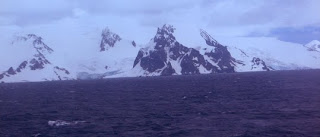Jan. 8...Wow! Last night as we crashed through the lower stretches of the Drake Passage, winds at 34+ knots, blasting water against the sides of our icebreaker, we asked if it would ever calm down.
Then, this morning we awoke to fairly calm breezes, enough to just feel the salt water mist on our faces and bright sunshine which in spite of the cold temperatures, feels warm to the beholder.
We are just reaching the South Shetland Islands, our first sighting of Antarctica. (See photo at right).
We sort felt a bit like British merchant William Smith who was thought to be the first person to see them only to find out later his discovery had been beaten by three days. Knowledge of this event wasn’t known until the 1940s when the records of the Russian Naval Officer were translated from their ten month Julian calendar into the twelve month Gregorian one we currently use today.
It doesn’t matter much who was first, but indeed, whenever we first see Antarctica we relive that same adventure of seeing land as if it came out of nowhere. Here we learned one basic requirement of science, the importance of recording data, of keeping records. Without doing so there is no way to demonstrate what you might claim
It is difficult to separate the whiteness of the land from the clouds where they meet the sea but to be sure, there is no doubt in our minds that here is snow and ice covered land.
We make our first expeditionary landing this afternoon, bringing along our electronic science probes and laptop to make measurements of some of the sea ice characteristics. We are prepared to make magnetic, temperature, UVa and UVb measurements as well as temporarily place samples in our spectrometer. Forget for a moment that this is a lab science class and enjoy the moment!
We’ll make our measurements, avoiding the Chinstrap Penguins, a rookery of which is all around us, as well as the many Antarctic terns, kelp gulls, snowy sheathbills and storm petrels. On the wide beach an old whalers dory lies weathering away.
The serrated cliffs, carved by eons of winds and sea ices, abut the shore. It is summer here in the Antarctic so the beaches are no longer covered with snow, revealing their normally well kept secrets. This face of the Antarctic is inviting, compelling us to look forward to tomorrow’s expedition.
God, thank you for letting us see this most pristine and most awesome place in your world!
Terry Flower




No comments:
Post a Comment